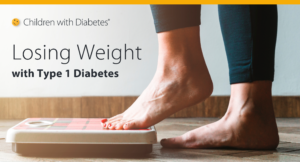CWD News
Diabetes Can Be Complicated
Despite the significant advancements in type 1 diabetes care over the last ten years, along with having multiple different hybrid closed-loop systems available, most Americans are not achieving glycemic goals.1 Although it’s wonderful to celebrate the trend of decreasing occurrences of complications experienced by people with type 1 diabetes, it’s also important to understand the risks that are still present. Drs. Subramanian and Hirsch from the University of Washington published a recent article discussing the implications of the 30-year follow-up results from the landmark DCCT and EDIC trials, which provides really important insight for people with type 1 diabetes.2 The […]
Read MoreGlucagon Options for People with Diabetes
When you have type 1 diabetes, your body stops making its own insulin. Additionally, the normal communication between the pancreas and the liver is disrupted. In someone without diabetes, the pancreas and the liver balance blood sugars through insulin and glucagon. Glucagon is a hormone that tells the liver to send glucose stores into the bloodstream, and it is made synthetically for people at risk for low blood glucose, such as people with diabetes. People with diabetes on insulin should have glucagon available in case of a hypoglycemic emergency. The original process of giving or receiving glucagon required mixing a […]
Read MoreDousing the Flames of Diabetes Burnout
Originally posted on Mar 16, 2022 Many people around the world are feeling the effects of burnout from having lived through a pandemic for the last couple of years. They’re tired of wearing masks and social distancing, and I completely understand it. But when you experience burnout from your diabetes, you are unable to simply stop thinking about it; you have to continue to care for yourself. So, what are you supposed to do when you experience diabetes burnout? Can you prevent burnout, or is it bound to happen to everyone at some point? What resources are available to you? […]
Read MoreLooking for Glucose Patterns
One of the advantages of diabetes technologies, particularly Continuous Glucose Monitors (CGMs), is having access to blood glucose data. Much like the many fitness data collection devices, CGMs identify patterns for the wearer to aid in behavior modification. For example, if you see a pattern of high glucose levels after breakfast every day, you are then alerted to the need to make a change in either insulin doses or the food consumed. But how do you know what changes to make? Do you have to ask your endocrinologist to look at your data to make insulin adjustments? How will you […]
Read MoreOvercoming Challenges for Women with Diabetes
In 2021, we published an article about needing more research on people with diabetes assigned female at birth that discussed a lack of research on common challenges that women with diabetes experience. In this article, we will present research articles published since the last article relating to women with diabetes. Please note, that when we are referring to “women” we are referring to anyone who has a uterus, as we will be discussing menstruation and menopause. Menstruation Research Updates Keeping your blood glucose levels in target range is not easy to do at baseline. When you add the changes in […]
Read MoreTips and Hacks to Make Diabetes Easier
When you are diagnosed with type 1 diabetes, you learn all the “rules” from your diabetes care team, such as how, when, and where (on what body part) to take insulin; how to count carbohydrates; what to do when you are ill; and what devices you should consider using. But, sometimes, even when you do everything as taught, your blood sugars don’t behave like you think they will. Sometimes you can take the same amount of insulin for the exact same meal three times in a row and can have three different results. There are many variables that can affect […]
Read MoreCWD President’s Medal for Innovation
Children with Diabetes is proud to announce the first CWD President’s Medal for Innovation. The award is presented to the health care professional(s) that exemplifies extraordinary leadership in using innovation and advancements of technology for insulin delivery and devices that help people with diabetes live a normal life. The annual award recipient(s) have been selected by CWD President Mr. Jeff Hitchcock from a list comprised of health care professionals within the CWD community. The first recipient(s) are Moshe Phillip, MD, and Tadej Battelino, MD, PhD. Dr Phillip is the director of the Institute for Endocrinology and Diabetes, National Center for […]
Read MoreTackling Health Disparities for Non-Hispanic Black Americans
In honor of Black History Month, CWD wants to recognize some of the organizations that are working diligently towards reducing racial health disparities in the U.S. Before we can do that, we will provide some important context so that the challenges and the work are better understood. What are health disparities or inequities? Health disparities are defined by the U.S. Centers for Disease Control and Prevention (CDC) as “preventable differences in the burden of disease, injury, violence, or opportunities to achieve optimal health that are experienced by socially disadvantaged populations.” (CDC: Health Disparities, 2020) There are many different types of […]
Read MoreSupporting Young Adults with Diabetes
Being a young adult is one of the most exciting times in life. Usually, it’s a period of life full of excitement and life changes. As a result, it can also be one of the most difficult times to manage diabetes.1 In fact, recent research has shown that less than 20% of people with type 1 diabetes aged 18-25 years are meeting their diabetes targets.2 One of the best ways to set your adolescent or young adult up for success is to ensure they have adequate support. Health care professionals and researchers refer the young adults as “emerging adults” that […]
Read MoreLosing Weight with Type 1 Diabetes
Almost three-quarters of adults 20 years or older in the United States are overweight, with 42.5% of adults meeting the C.D.C.’s definition for obese.1 For people with type 1 diabetes, the incidence may be even higher according to studies over the past ten years, partially due to the increase in weight gain when on intensive insulin therapy.2 Increased weight adds additional challenges for people with type 1 diabetes, including insulin resistance and increased risk for complications. One of the biggest barriers to losing weight for people with diabetes is fear of hypoglycemia that goes along with exercise, weight loss and […]
Read More








